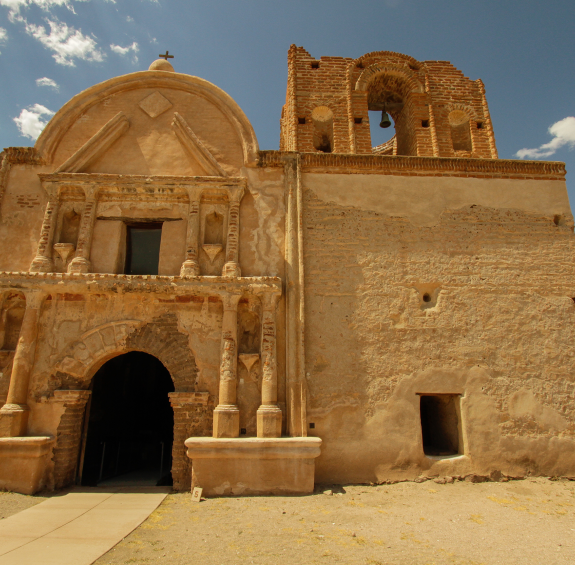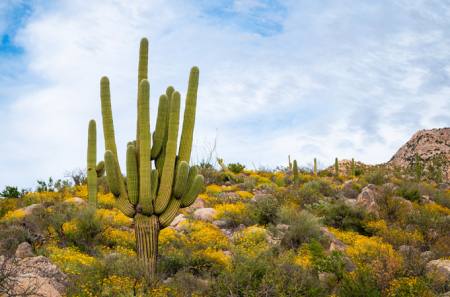Heritage & Culture
The Remains of New Spain
Hispanic culture has shaped Arizona’s architecture, colored its art and flavored its food. And it all began with a legend and a treasure hunt. After Spanish conquistadors conquered the Aztecs and Incas and pillaged their precious metals, rumors circulated that greater riches were hidden farther north.
In 1539, Friar Marcos de Niza journeyed to what is now the Southwestern U.S. to find the legendary Seven Cities of Cibola. Whether de Niza was suffering from heatstroke hallucinations or telling his bosses what they wanted to hear, he reported that he saw the city of gold. Not long after, Francisco Vázquez de Coronado charted an expedition to claim the gold but found only adobe pueblos.

In the late 1600s, still seeking mineral wealth, the Spanish military and clergy set up outposts in what is now Southern Arizona to control and convert the Native peoples to Christianity. Father Eusebio Francisco Kino formed good relations with the Native communities and founded several missions, including one south of present-day Tucson.
A century later, the Spanish and O’odham people built a church on that site called San Xavier del Bac. Widely considered the country’s best example of Spanish Colonial architecture, this striking structure’s interior features colorful statues and frescoes that one conservator called “the Sistine Chapel of North America.” Free tours are offered Monday through Saturday.
Kino also founded a mission eventually called San José de Tumacácori, south of artsy Tubac. Around 1800, the Spanish and O’odham began constructing a church on the site, but conflicts and funding problems prevented its completion. Still, it’s well worth visiting Tumacácori National Historical Park to marvel at this semi-ruin and gaze up at its domed ceiling.
“The Tumacácori mission is just a delight,” says Betsy Fearnow of the Tubac Historical Society. She encourages travelers to walk four miles along the riverside Juan Bautista de Anza National Historic Trail between Tumacácori and Tubac Presidio State Historic Park, which showcases the ruins of an 18th-century Spanish fort.

On third Saturdays from October through March, a free shuttle runs between the sites. The trail follows the route that de Anza, a Spanish military leader, walked from Tubac to San Francisco to colonize California. “California has so much Spanish heritage,” Fearnow says, “but it all started here.”
In the early 1900s, Spanish Colonial Revival architecture swept the nation. Visitors can see these captivating buildings by strolling around Brophy College Preparatory in Phoenix, touring the Orpheum Theatre in Phoenix, and staying at The Wigwam resort in Litchfield Park.
Architecture buffs can also shop under Historic Ajo Plaza’s Spanish-style archways in Ajo and pedal with Tucson Bike Tours to a Spanish presidio and the pastel-hued, Hispanic-influenced Barrio Historic District.
This article was originally published in the 2023 Arizona Official State Travel Guide.
Find these common features
Want to spot a Spanish-style building in the wild? Keep an eye out for these common characteristics and architectural features.
- Stucco walls.
- Built from local materials.
- Wooden support beams and doors.
- Clay roof tiles.
- Outdoor courtyards, balconies and patios.
- Colorful tilework.
- Arches and curves.
- Wrought iron details.
Tumacácori National Historical Park
Visit a 19th-century Franciscan mission at one of the oldest national park sites in the United States.
Cities
Tubac
Spend some time in this Spanish Presidio turned artist colony, where creativity is as present in the galleries and shops as it is in restaurant...
VIVA LA CULTURA
Arizona’s Hispanic and Latino Culture
Experience Arizona's vibrant Hispanic heritage at historic sites and colorful festivals across the state. Find authentic and award-winning...
Cities
Tucson
Visit Arizona’s second-largest city, a UNESCO City of Gastronomy and a year-round outdoor playground. You can be secluded or social in Tucson....









